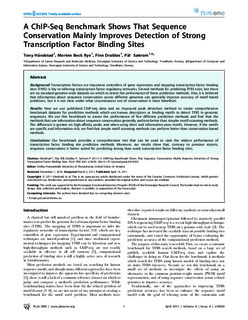| dc.contributor.author | Håndstad, Tony | |
| dc.contributor.author | Rye, Morten Beck | |
| dc.contributor.author | Drabløs, Finn | |
| dc.contributor.author | Sætrom, Pål | |
| dc.date.accessioned | 2015-10-30T11:17:56Z | |
| dc.date.accessioned | 2015-11-25T14:13:56Z | |
| dc.date.available | 2015-10-30T11:17:56Z | |
| dc.date.available | 2015-11-25T14:13:56Z | |
| dc.date.issued | 2011 | |
| dc.identifier.citation | PLoS ONE 2011, 6(4) | nb_NO |
| dc.identifier.issn | 1932-6203 | |
| dc.identifier.uri | http://hdl.handle.net/11250/2365788 | |
| dc.description.abstract | Background:
Transcription factors are important controllers of gene expression and mapping transcription factor binding sites (TFBS) is key to inferring transcription factor regulatory networks. Several methods for predicting TFBS exist, but there are no standard genome-wide datasets on which to assess the performance of these prediction methods. Also, it is believed that information about sequence conservation across different genomes can generally improve accuracy of motif-based predictors, but it is not clear under what circumstances use of conservation is most beneficial.
Results:
Here we use published ChIP-seq data and an improved peak detection method to create comprehensive benchmark datasets for prediction methods which use known descriptors or binding motifs to detect TFBS in genomic sequences. We use this benchmark to assess the performance of five different prediction methods and find that the methods that use information about sequence conservation generally perform better than simpler motif-scanning methods. The difference is greater on high-affinity peaks and when using short and information-poor motifs. However, if the motifs are specific and information-rich, we find that simple motif-scanning methods can perform better than conservation-based methods.
Conclusions:
Our benchmark provides a comprehensive test that can be used to rank the relative performance of transcription factor binding site prediction methods. Moreover, our results show that, contrary to previous reports, sequence conservation is better suited for predicting strong than weak transcription factor binding sites. | nb_NO |
| dc.language.iso | eng | nb_NO |
| dc.publisher | Public Library of Science | nb_NO |
| dc.title | A ChIP-Seq Benchmark Shows That Sequence Conservation Mainly Improves Detection of Strong Transcription Factor Binding Sites | nb_NO |
| dc.type | Journal article | nb_NO |
| dc.type | Peer reviewed | en_GB |
| dc.date.updated | 2015-10-30T11:17:56Z | |
| dc.source.volume | 6 | nb_NO |
| dc.source.journal | PLoS ONE | nb_NO |
| dc.source.issue | 4 | nb_NO |
| dc.identifier.doi | 10.1371/journal.pone.0018430 | |
| dc.identifier.cristin | 803734 | |
| dc.description.localcode | © 2011 Håndstad et al. This is an open-access article distributed under the terms of the Creative Commons Attribution License, which permits unrestricted use, distribution, and reproduction in any medium, provided the original author and source are credited. | nb_NO |
